PEAP under UWNs with ACS 5.1 and Windows 2003 Server
Available Languages
Contents
Introduction
This document describes how to configure secure wireless access using Wireless LAN controllers, Microsoft Windows 2003 software and Cisco Secure Access Control Server (ACS) 5.1 via Protected Extensible Authentication Protocol (PEAP) with Microsoft Challenge Handshake Authentication Protocol (MS-CHAP) version 2.
Note: For information about the deployment of secure wireless, refer to the Microsoft Wi-Fi website ![]() and Cisco SAFE Wireless Blueprint.
and Cisco SAFE Wireless Blueprint.
Prerequisites
Requirements
There is an assumption that the installer has knowledge of basic Windows 2003 installation and Cisco Wireless LAN controller installation as this document only covers the specific configurations to facilitate the tests.
For initial installation and configuration information for the Cisco 5508 Series Controllers, refer to the Cisco 5500 Series Wireless Controller Installation Guide. For initial installation and configuration information for the Cisco 2100 Series Controllers, refer to the Quick Start Guide: Cisco 2100 Series Wireless LAN Controller.
Microsoft Windows 2003 installation and configuration guides can be found at Installing Windows Server 2003 R2 ![]() .
.
Before you begin, install the Microsoft Windows Server 2003 with SP1 operating system on each of the servers in the test lab and update all Service Packs. Install the controllers and lightweight access points (LAPs) and ensure that the latest software updates are configured.
Windows Server 2003 with SP1, Enterprise Edition, is used so that auto-enrollment of user and workstation certificates for PEAP authentication can be configured. Certificate auto-enrollment and autorenewal make it easier to deploy certificates and improve security by automatically expiring and renewing certificates.
Components Used
The information in this document is based on these software and hardware versions:
-
Cisco 2106 or 5508 Series Controller that runs 7.0.98.0
-
Cisco 1142 Lightweight Access Point Protocol (LWAPP) AP
-
Windows 2003 Enterprise with Internet Information Server (IIS), Certificate Authority (CA), DHCP, and Domain Name System (DNS) installed
-
Cisco 1121 Secure Access Control System Appliance (ACS) 5.1
-
Windows XP Professional with SP (and updated Service Packs) and wireless network interface card (NIC) (with CCX v3 support) or third party supplicant.
-
Cisco 3750 Switch
The information in this document was created from the devices in a specific lab environment. All of the devices used in this document started with a cleared (default) configuration. If your network is live, make sure that you understand the potential impact of any command.
Conventions
Refer to the Cisco Technical Tips Conventions for more information on document conventions.
Configure
In this section, you are presented with the information to configure the features described in this document.
Note: Use the Command Lookup Tool (registered customers only) to obtain more information on the commands used in this section.
Network Diagram
This document uses this network setup:
Cisco Secure Wireless Lab Topology 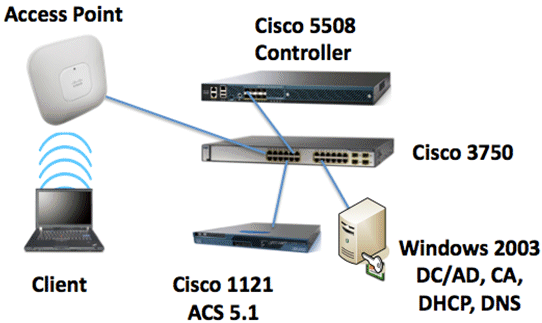
The primary purpose of this document is to provide you the step-by-step procedure to implement the PEAP under Unified Wireless Networks with ACS 5.1 and the Windows 2003 Enterprise server. The main emphasis is on auto-enrollment of the client so that the client auto-enrolls and takes the certificate from the server.
Note: In order to add Wi-Fi Protected Access (WPA)/WPA2 with Temporal Key Integrity Protocol (TKIP)/Advanced Encryption Standard (AES) to Windows XP Professional with SP, refer to WPA2/Wireless Provisioning Services Information Element (WPS IE) update for Windows XP with Service Pack 2 ![]() .
.
Windows Enterprise 2003 Setup with IIS, Certificate Authority, DNS, DHCP (CA)
CA (democa)
CA is a computer that runs Windows Server 2003 with SP2, Enterprise Edition, and performs these roles:
-
A domain controller for the demo.local domain that runs IIS
-
A DNS server for the demo.local DNS domain
-
A DHCP server
-
Enterprise root CA for the demo.local domain
Perform these steps in order to configure CA for these services:
Perform Basic Installation and Configuration
Perform these steps:
-
Install Windows Server 2003 with SP2, Enterprise Edition, as a stand-alone server.
-
Configure the TCP/IP protocol with the IP address of 10.0.10.10 and the subnet mask of 255.255.255.0.
Configure the Computer as a Domain Controller
Perform these steps:
-
In order to start the Active Directory Installation wizard, choose Start > Run, type dcpromo.exe, and click OK.
-
On the Welcome to the Active Directory Installation Wizard page, click Next.
-
On the Operating System Compatibility page, click Next.
-
On the Domain Controller Type page, select Domain Controller for a new Domain and click Next.
-
On the Create New Domain page, select Domain in a new forest and click Next.
-
On the Install or Configure DNS page, select No, just install and configure DNS on this computer and click Next.
-
On the New Domain Name page, type demo.local and click Next.
-
On the NetBIOS Domain Name page, enter the Domain NetBIOS name as demo and click Next.
-
In the Database and Log Folders Locations page, accept the default Database and Log Folders directories and click Next.
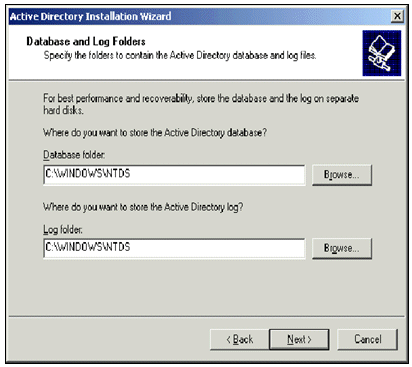
-
In the Shared System Volume page, verify that the default folder location is correct and click Next.
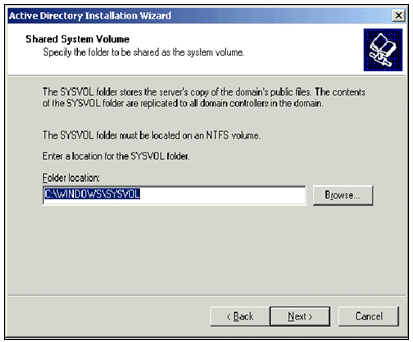
-
On the Permissions page, verify that Permissions compatible only with Windows 2000 or Windows Server 2003 operating systems is selected and click Next.
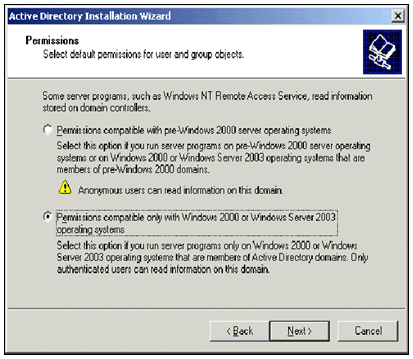
-
On the Directory Services Restore Mode Administration Password page, leave the password boxes blank and click Next.
-
Review the information on the Summary page and click Next.
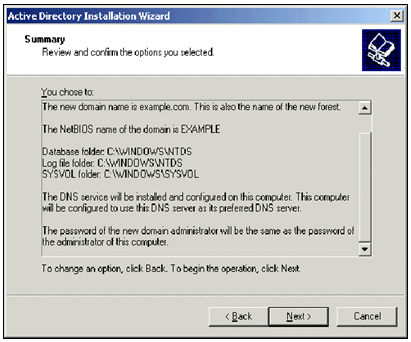
-
When you are done with the Active Directory installation, click Finish.
-
When prompted to restart the computer, click Restart Now.
Raise the Domain Functional Level
Perform these steps:
-
Open the Active Directory Domains and Trusts snap-in from the Administrative Tools folder (Start > Programs > Administrative Tools > Active Directory Domains and Trusts), and then right-click the domain computer CA.demo.local.
-
Click Raise Domain Functional Level, and then select Windows Server 2003 on the Raise Domain Functional Level page.
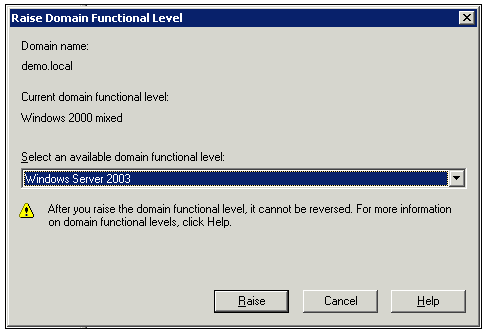
-
Click Raise, click OK, and then click OK again.
Install and Configure DHCP
Perform these steps:
-
Install Dynamic Host Configuration Protocol (DHCP) as a Networking Service component by using Add or Remove Programs in the Control Panel.
-
Open the DHCP snap-in from the Administrative Tools folder (Start > Programs > Administrative Tools > DHCP), and then highlight the DHCP server, CA.demo.local.
-
Click Action, and then click Authorize in order to authorize the DHCP service.
-
In the console tree, right-click CA.demo.local, and then click New Scope.
-
On the Welcome page of the New Scope wizard, click Next.
-
On the Scope Name page, type CorpNet in the Name field.
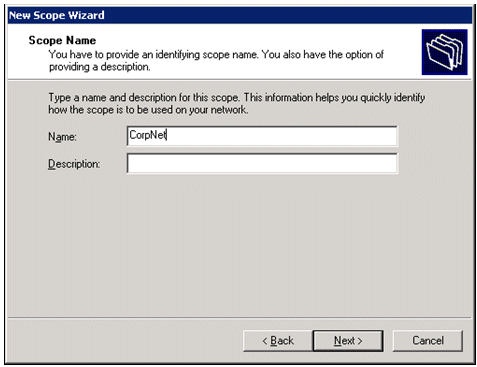
-
Click Next and fill in these parameters:
-
Start IP address - 10.0.20.1
-
End IP address - 10.0.20.200
-
Length - 24
-
Subnet mask - 255.255.255.0
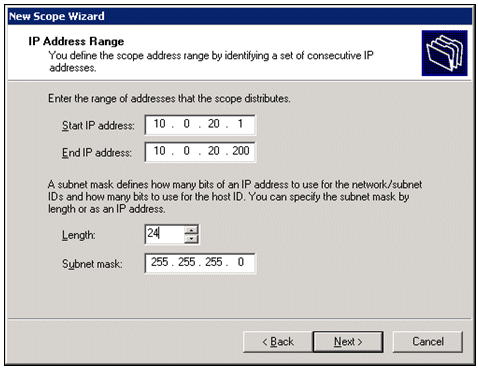
-
-
Click Next and enter 10.0.20.1 for the Start IP address and 10.0.20.100 for the End IP address to be excluded. Then click Next. This reserves the IP addresses in the range from 10.0.20.1 to 10.0.20.100. These reserve IP addresses are not allotted by the DHCP server.
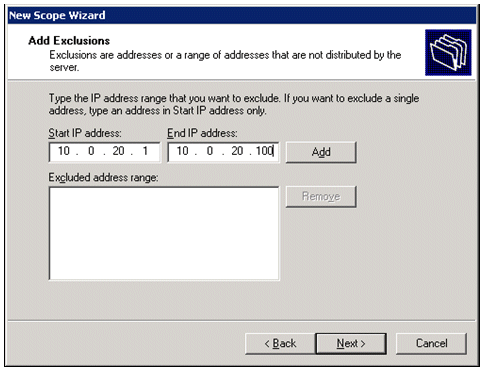
-
On the Lease Duration page, click Next.
-
On the Configure DHCP Options page, choose Yes, I want to configure these options now and click Next.
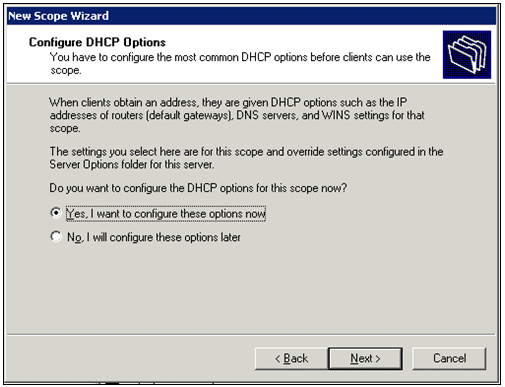
-
On the Router (Default Gateway) page add the default router address of 10.0.20.1 and click Next.
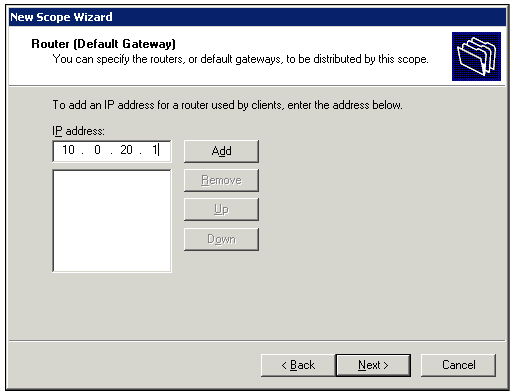
-
On the Domain Name and DNS Servers page, type demo.local in the Parent domain field, type 10.0.10.10 in the IP address field, and then click Add and click Next.
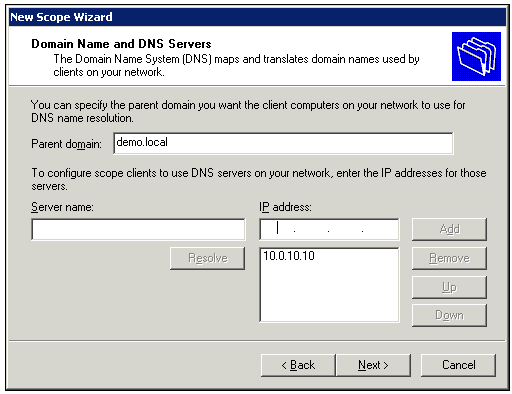
-
On the WINS Servers page, click Next.
-
On the Activate Scope page, choose Yes, I want to activate this scope now and click Next.
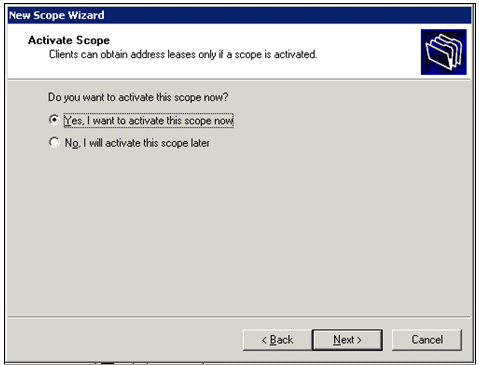
-
When you finish with the New Scope Wizard page, click Finish.
Install Certificate Services
Perform these steps:
Note: IIS must be installed before you install Certificate Services and the user should be part of the Enterprise Admin OU.
-
In Control Panel, open Add or Remove Programs, and then click Add/Remove Windows Components.
-
In the Windows Components Wizard page, choose Certificate Services, and then click Next.
-
On the CA Type page, choose Enterprise root CA and click Next.
-
In the CA Identifying Information page, type democa in the Common name for this CA box. You can also enter the other optional details. Then click Next and accept the defaults on the Certificate Database Settings page.
-
Click Next. Upon completion of the installation, click Finish.
-
Click OK after you read the warning message about installing IIS.
Verify Administrator Permissions for Certificates
Perform these steps:
-
Choose Start > Administrative Tools > Certification Authority.
-
Right-click democa CA and then click Properties.
-
On the Security tab, click Administrators in the Group or User names list.
-
In the Permissions for Administrators list, verify that these options are set to Allow:
-
Issue and Manage Certificates
-
Manage CA
-
Request Certificates
If any of these are set to Deny or are not selected, set the permissions to Allow.
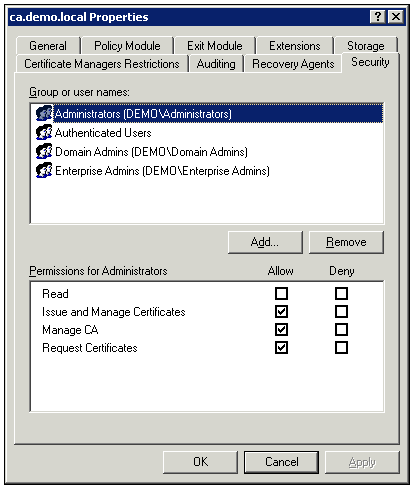
-
-
Click OK to close the democa CA Properties dialog box, and then close Certification Authority.
Add Computers to the Domain
Perform these steps:
Note: If the computer is already added to the domain, proceed to Add Users to the Domain.
-
Open the Active Directory Users and Computers snap-in.
-
In the console tree, expand demo.local.
-
Right-click Computers, click New, and then click Computer.
-
In the New Object – Computer dialog box, type the name of the computer in the Computer name field and click Next. This example uses the computer name Client.
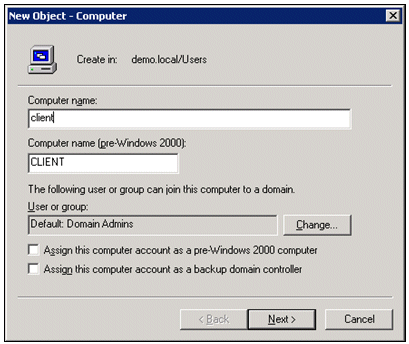
-
In the Managed dialog box, click Next.
-
In the New Object – Computer dialog box, click Finish.
-
Repeat steps 3 through 6 in order to create additional computer accounts.
Allow Wireless Access to Computers
Perform these steps:
-
In the Active Directory Users and Computers console tree, click the Computers folder and right-click on the computer for which you want to assign wireless access. This example shows the procedure with computer Client which you added in step 7. Click Properties, and then go to the Dial-in tab.
-
In the Remote Access Permission, choose Allow access and click OK.
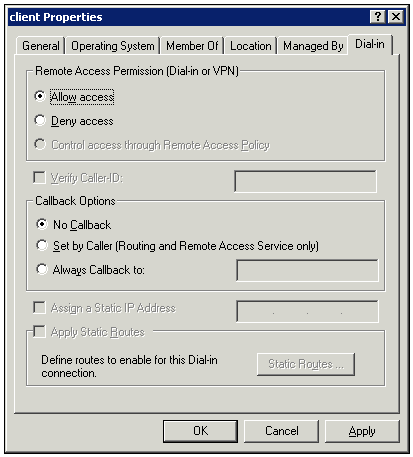
Add Users to the Domain
Perform these steps:
-
In the Active Directory Users and Computers console tree, right-click Users, click New, and then click User.
-
In the New Object – User dialog box, type the name of the wireless user. This example uses the name wirelessuser in the First name field, and wirelessuser in the User logon name field. Click Next.
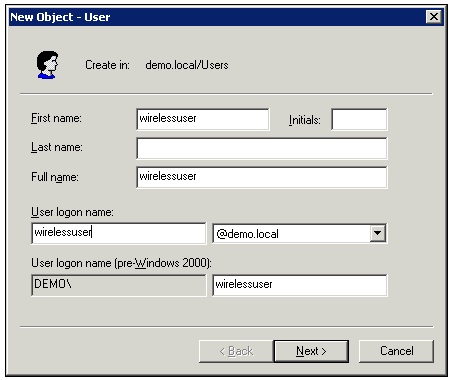
-
In the New Object – User dialog box, type a password of your choice in the Password and Confirm password fields. Clear the User must change password at next logon check box, and click Next.
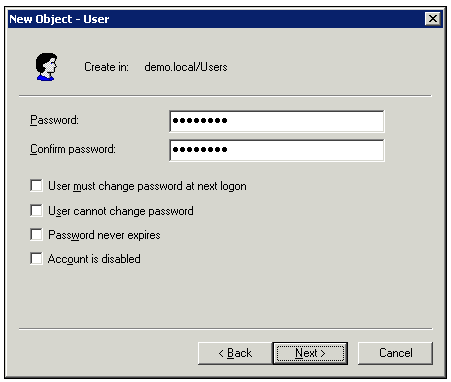
-
In the New Object – User dialog box, click Finish.
-
Repeat steps 2 through 4 in order to create additional user accounts.
Allow Wireless Access to Users
Perform these steps:
-
In the Active Directory Users and Computers console tree, click the Users folder, right-click wirelessuser, click Properties, and then go to the Dial-in tab.
-
In the Remote Access Permission, choose Allow access and click OK.
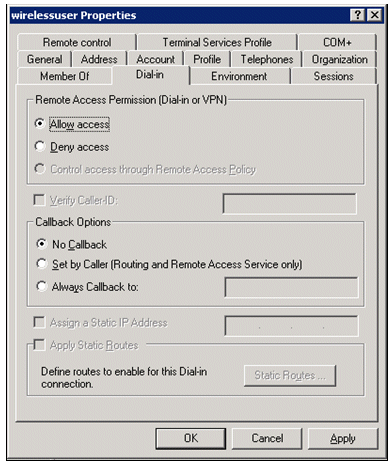
Add Groups to the Domain
Perform these steps:
-
In the Active Directory Users and Computers console tree, right-click Users, click New, and then click Group.
-
In the New Object – Group dialog box, type the name of the group in the Group name field and click OK. This document uses the group name wirelessusers.
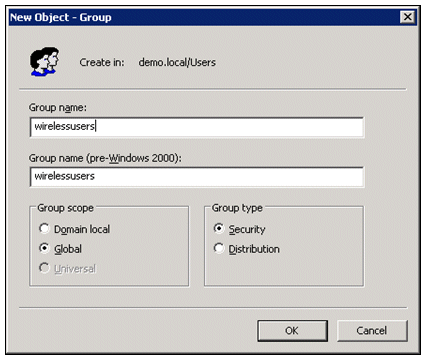
Add Users to the wirelessusers Group
Perform these steps:
-
In the details pane of Active Directory Users and Computers, double-click on the group WirelessUsers.
-
Go to the Members tab and click Add.
-
In the Select Users, Contacts, Computers, or Groups dialog box, type the name of the users that you want to add to the group. This example shows how to add the user wirelessuser to the group. Click OK.
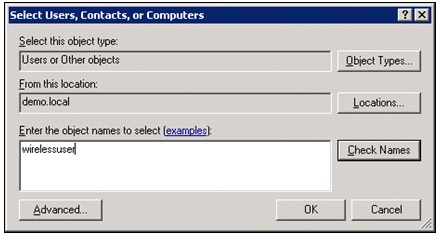
-
In the Multiple Names Found dialog box, click OK. The wirelessuser user account is added to the wirelessusers group.
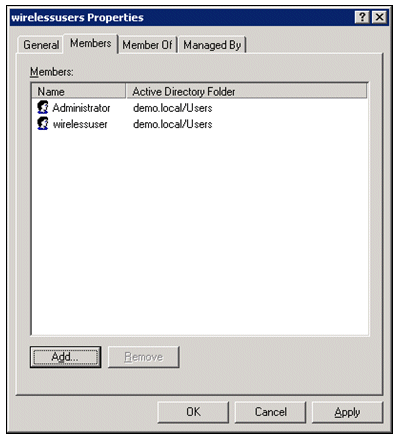
-
Click OK in order to save changes to the wirelessusers group.
-
Repeat this procedure to add more users to the group.
Add Client Computers to the wirelessusers Group
Perform these steps:
-
Repeat steps 1 and 2 in the Add Users to the wirelessusers Group section of this document.
-
In the Select Users, Contacts, or Computers dialog box, type the name of the computer that you want to add to the group. This example shows how to add the computer named client to the group.
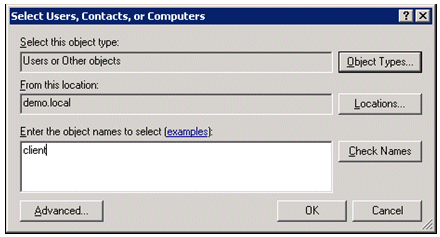
-
Click Object Types, clear the Users check box, and then check Computers.
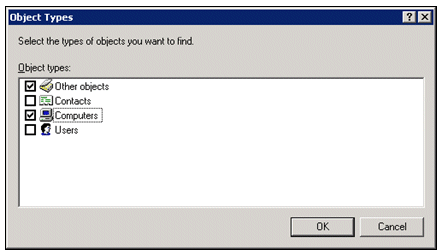
-
Click OK twice. The CLIENT computer account is added to the wirelessusers group.
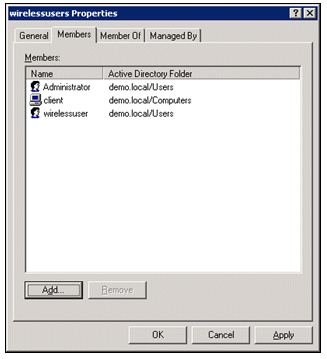
-
Repeat the procedure to add more computers to the group.
Cisco 1121 Secure ACS 5.1
Installation Using the CSACS-1121 Series Appliance
The CSACS-1121 appliance is preinstalled with the ACS 5.1 software. This section gives you an overview of the installation process and the tasks that you must perform before installing ACS.
-
Connect the CSACS-1121 to the network and appliance console. See Chapter 4, "Connecting Cables."
-
Power up the CSACS-1121 appliance. See Chapter 4, "Powering Up the CSACS-1121 Series Appliance."
-
Run the setup command at the CLI prompt to configure the initial settings for the ACS server. See Running the Setup Program.
Install the ACS Server
This section describes the installation process for the ACS server on the CSACS-1121 Series appliance.
For detailed information on the installation of the Cisco Secure ACS Server refer to Installation and Upgrade Guide for the Cisco Secure Access Control System 5.1.
Cisco WLC5508 Controller Configuration
Create the Necessary Configuration for WPAv2/WPA
Perform these steps:
Note: The assumption is that the controller has basic connectivity to the network and IP reachability to the management interface is successful.
-
Browse to https://10.0.1.10 in order to login to the controller.
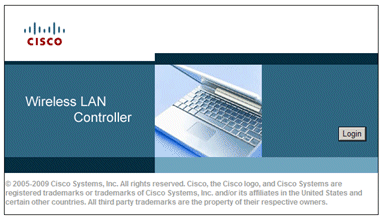
-
Click Login.
-
Log in with the default user admin and default password admin.
-
Create a new Interface for VLAN mapping under the Controller menu.
-
Click Interfaces.
-
Click New.
-
In the Interface name field, enter Employee. (This field can be any value you like.)
-
In the VLAN ID field, enter 20. (This field can be any VLAN that is carried in the network.)
-
Click Apply.
-
Configure the information as this Interfaces > Edit window shows:
-
Interface IP Address - 10.0.20.2
-
Netmask - 255.255.255.0
-
Gateway - 10.0.10.1
-
Primary DHCP - 10.0.10.10
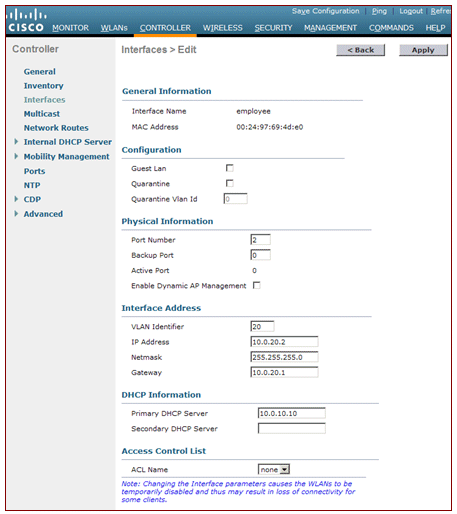
-
-
Click Apply.
-
Click the WLANs tab.
-
Choose Create New, and click Go.
-
Enter a Profile Name, and, in the WLAN SSID field, enter Employee.

-
Choose an ID for the WLAN, and click Apply.
-
Configure the information for this WLAN when the WLANs > Edit window appears.
Note: WPAv2 is the chosen Layer 2 encryption method for this lab. In order to allow WPA with TKIP-MIC clients to associate to this SSID, you can also check the WPA compatibility mode and Allow WPA2 TKIP Clients boxes or those clients that do not support the 802.11i AES encryption method.
-
On the WLANs > Edit screen, click the General tab.
-
Make sure that the Status box is checked for Enabled and the appropriate Interface (employee) is chosen. Also, make sure to check the Enabled check box for Broadcast SSID.
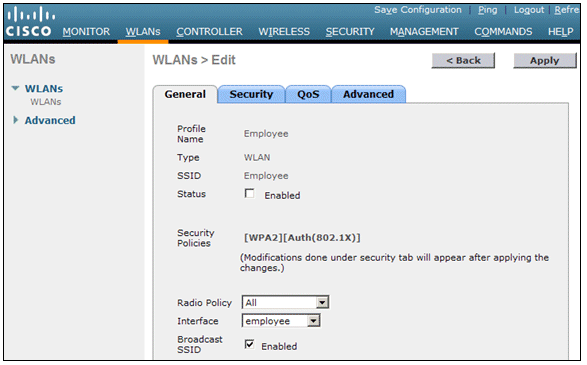
-
Click the Security tab.
-
Under the Layer 2 sub-menu, check WPA + WPA2 for Layer 2 Security. For WPA2 encryption, check AES + TKIP in order to allow TKIP clients.
-
Choose 802.1x as the authentication method.
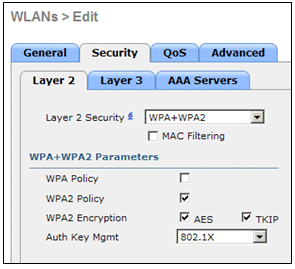
-
Skip the Layer 3 sub-menu as it is not required. Once the RADIUS server is configured, the appropriate server can be chosen from the Authentication menu.
-
The QoS and Advanced tabs can be left at default unless any special configurations are required.
-
Click the Security menu to add the RADIUS Server.
-
Under the RADIUS sub-menu, click Authentication. Then, click New.
-
Add the RADIUS server IP address (10.0.10.20) which is the ACS server configured earlier.
-
Make sure that the shared key matches the AAA client configured in the ACS server. Make sure that the Network User box is checked and click Apply.
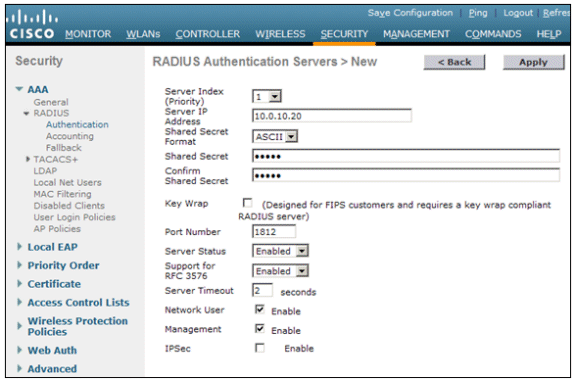
-
The basic configuration is now complete and you can begin to test PEAP.
PEAP Authentication
PEAP with MS-CHAP version 2 requires certificates on the ACS servers but not on the wireless clients. Auto enrollment of computer certificates for the ACS servers can be used to simplify a deployment.
In order to configure CA server to provide auto-enrollment for computer and user certificates, complete the procedures in this section.
Note: Microsoft has changed the Web Server template with the release of the Windows 2003 Enterprise CA so that keys are no longer exportable and the option is grayed out. There are no other certificate templates supplied with certificate services that are for server authentication and give the ability to mark keys as exportable that are available in the drop-down so you have to create a new template that does so.
Note: Windows 2000 allows for exportable keys and these procedures do not need to be followed if you use Windows 2000.
Install the Certificate Templates Snap-in
Perform these steps:
-
Choose Start > Run, enter mmc, and click OK.
-
On the File menu, click Add/Remove Snap-in, and then click Add.
-
Under Snap-in, double-click Certificate Templates, click Close, and then click OK.
-
In the console tree, click Certificate Templates. All of the certificate templates appear in the Details pane.
-
In order to bypass steps 2 through 4, enter certtmpl.msc which opens the Certificate Templates snap-in.
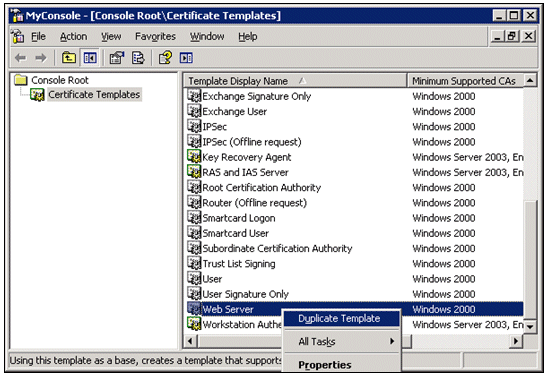
Create the Certificate Template for the ACS Web Server
Perform these steps:
-
In the Details pane of the Certificate Templates snap-in, click the Web Server template.
-
On the Action menu, click Duplicate Template.
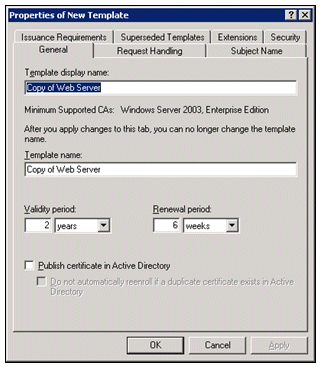
-
In the Template display name field, enter ACS.
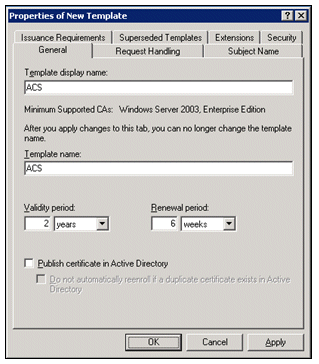
-
Go to the Request Handling tab and check Allow private key to be exported. Also ensure that Signature and Encryption is selected from the Purpose drop-down menu.
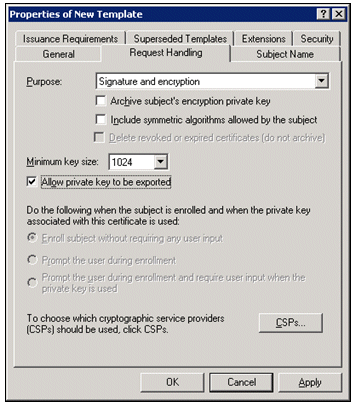
-
Choose Requests must use one of the following CSPs and check Microsoft Base Cryptographic Provider v1.0. Uncheck any other CSPs that are checked, and click OK.
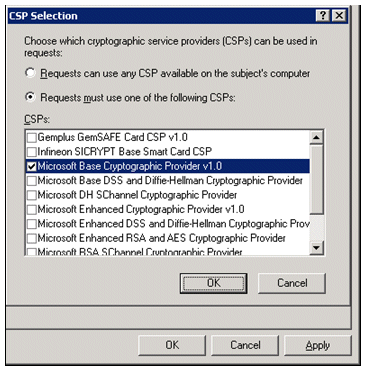
-
Go to the Subject Name tab, choose Supply in the request, and click OK.
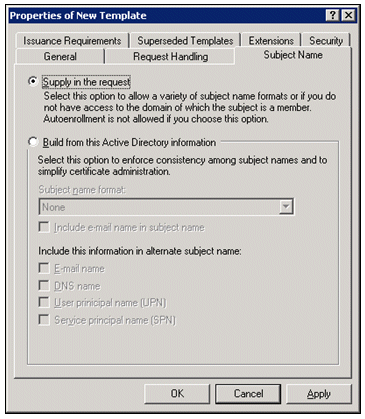
-
Go to the Security tab, highlight the Domain Admins Group, and make sure that the Enroll option is checked under Allowed.
Note: If you choose to build from this Active Directory information only check the User principal name (UPN) and uncheck the Include email name in subject name and E-mail name because an e-mail name was not entered for the Wireless User account in the Active Directory Users and Computers snap-in. If you do not disable these two options, auto-enrollment attempts to use e-mail, which results in an auto-enrollment error.
-
There are additional security measures if needed to prevent certificates from being automatically pushed out. These can be found under the Issuance Requirements tab. This is not discussed further in this document.
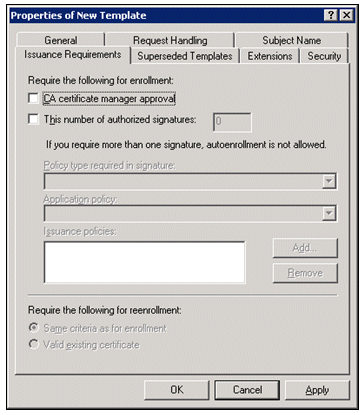
-
Click OK in order to save the template and move onto issuing this template from the Certificate Authority snap-in.
Enable the New ACS Web Server Certificate Template
Perform these steps:
-
Open the Certification Authority snap-in. Perform steps 1 through 3 in the Create the Certificate Template for the ACS Web Server section, choose the Certificate Authority option, choose Local Computer, and click Finish.
-
In the Certificate Authority console tree, expand ca.demo.local, and then right-click Certificate Templates.
-
Go to New > Certificate Template to Issue.
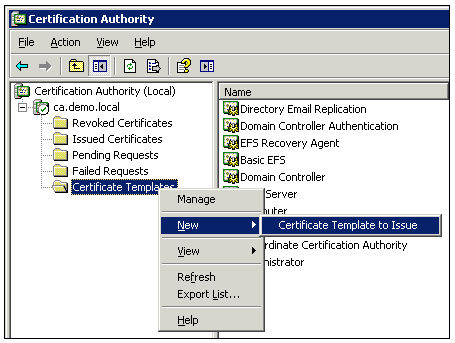
-
Click the ACS Certificate Template.
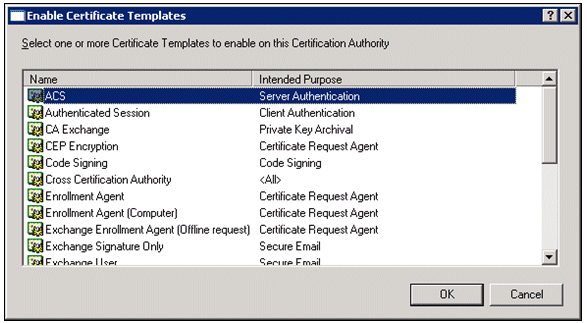
-
Click OK and open the Active Directory Users and Computers snap-in.
-
In the console tree, double-click Active Directory Users and Computers, right-click demo.local, and then click Properties.
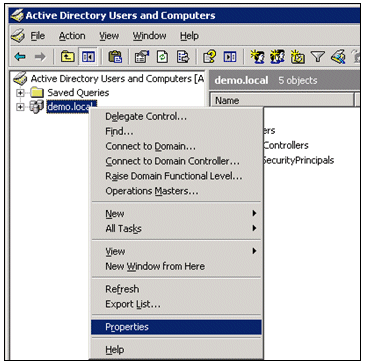
-
On the Group Policy tab, click Default Domain Policy, and then click Edit. This opens the Group Policy Object Editor snap-in.
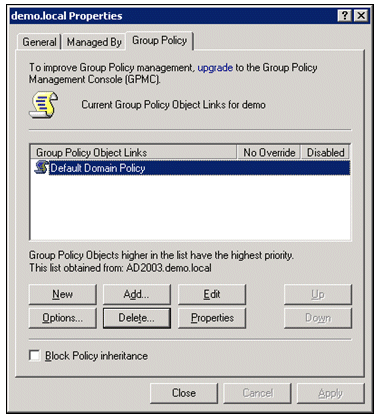
-
In the console tree, expand Computer Configuration > Windows Settings > Security Settings > Public Key Policies, and then choose Automatic Certificate Request Settings.
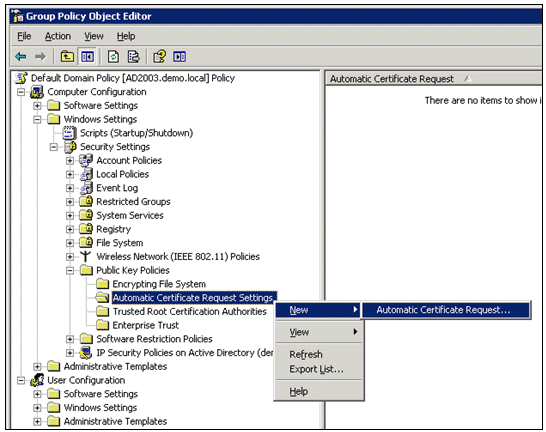
-
Right-click Automatic Certificate Request Settings, and choose New > Automatic Certificate Request.
-
On the Welcome to the Automatic Certificate Request Setup Wizard page, click Next.
-
On the Certificate Template page, click Computer, and then click Next.
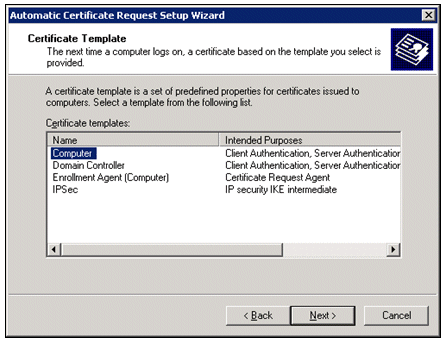
-
When you complete the Automatic Certificate Request Setup Wizard page, click Finish. The Computer certificate type now appears in the details pane of the Group Policy Object Editor snap-in.
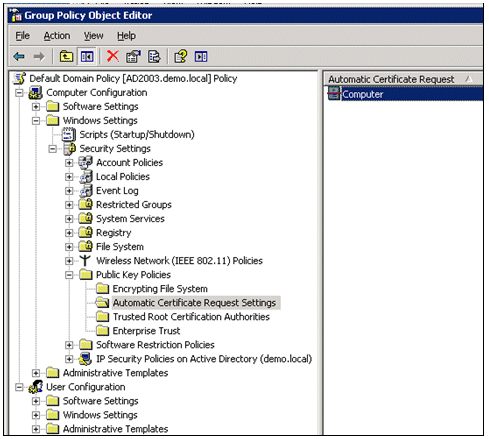
-
In the console tree, expand User Configuration > Windows Settings > Security Settings > Public Key Policies.
-
In the details pane, double-click Auto-enrollment Settings.
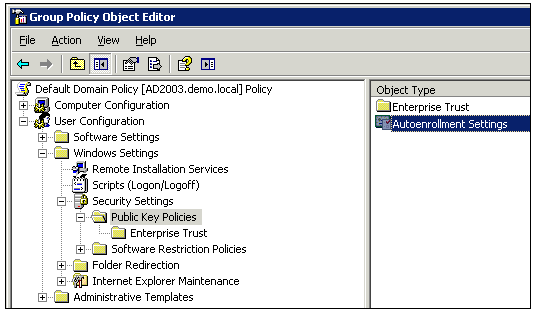
-
Choose Enroll certificates automatically and check Renew expired certificates, update pending certificates and remove revoked certificates and Update certificates that use certificate templates.
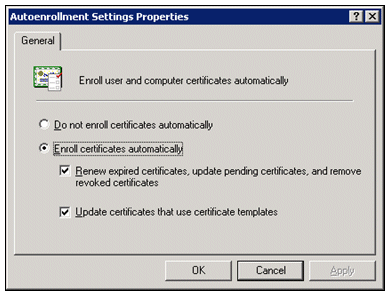
-
Click OK.
ACS 5.1 Certificate Setup
Configure Exportable Certificate for ACS
Note: The ACS server must obtain a server certificate from the enterprise root CA server in order to authenticate a WLAN PEAP client.
Note: Make sure that the IIS Manager is not open during the certificate setup process as causes problems with cached information.
-
Log in to the ACS server with an account Admin rights.
-
Go to System Administration > Configuration > Local Server Certificates. Click Add.
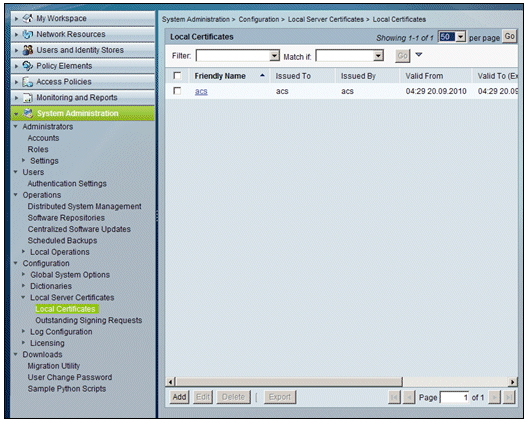
-
When you choose a server certificate creation method, choose Generate Certificate Signing Request. Click Next.
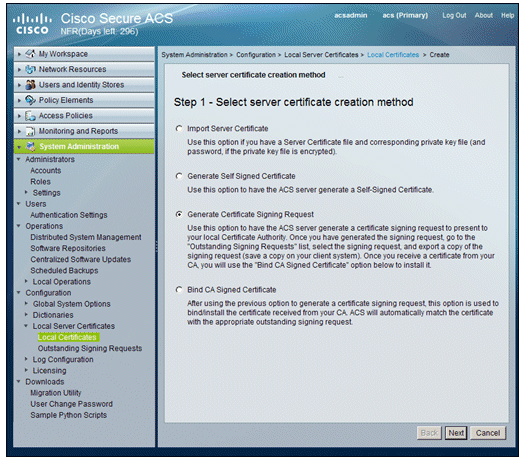
-
Enter a certificate subject and key length as the example, then click Finish:
-
Certificate Subject - CN=acs.demo.local
-
Key Length - 1024

-
-
ACS will prompt that a certificate signing request has been generated. Click OK.

-
Under System Administration, go to Configuration > Local Server Certificates > Outstanding Signing Requests.
Note: The reason for this step is that Windows 2003 does not allow for exportable keys and you need to generate a certificate request based on the ACS Certificate that you created earlier that does.
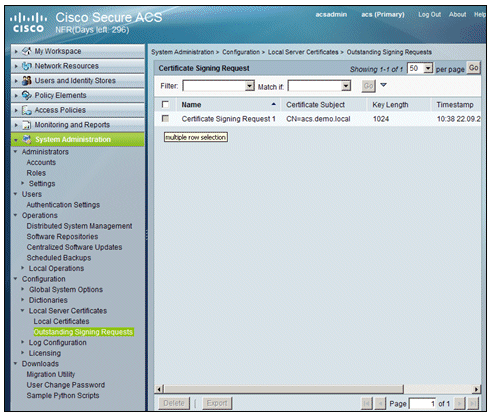
-
Choose the Certificate Signing Request entry, and click Export.
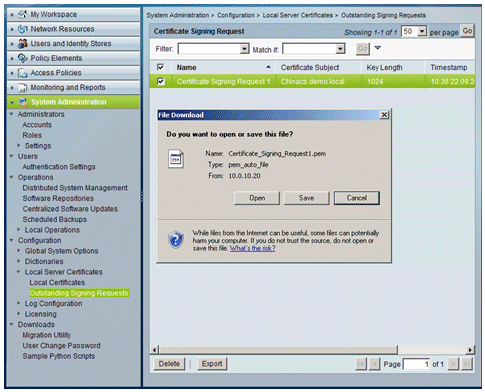
-
Save the ACS certificate .pem file to the desktop.
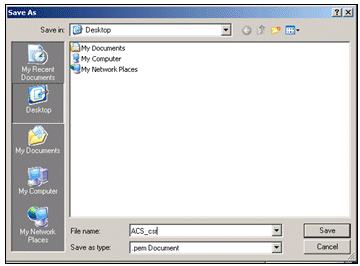
Install the Certificate in ACS 5.1 Software
Perform these steps:
-
Open a browser and connect to CA server URL http://10.0.10.10/certsrv.
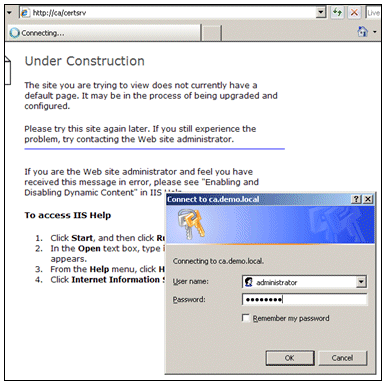
-
The Microsoft Certificate Services window appears. Choose Request a certificate.
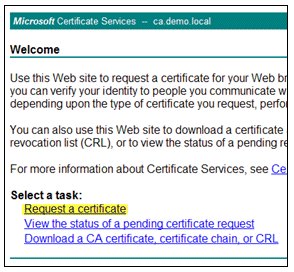
-
Click to submit an advanced certificate request.
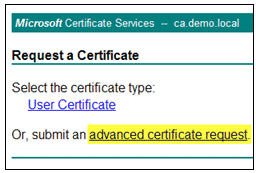
-
In the advanced request, click Submit a certificate request using a base-64-encoded…
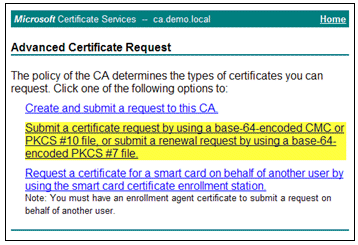
-
In the Saved Request field, if browser security permits, browse to the previous ACS certificate request file and insert.
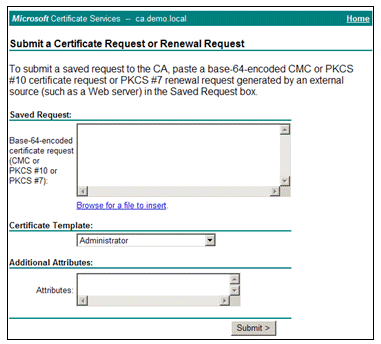
-
The browser’s security settings may not allow accessing the file on a disk. If so, click OK to perform a manual paste.

-
Locate the ACS *.pem file from the previous ACS export. Open the file using a text editor (for example, Notepad).
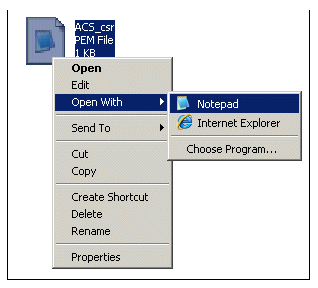
-
Highlight the entire content of the file, and click Copy.
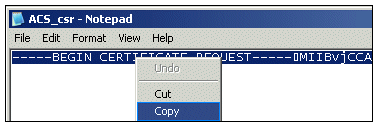
-
Return to the Microsoft certificate request window. Paste the copied content into the Saved Request field.
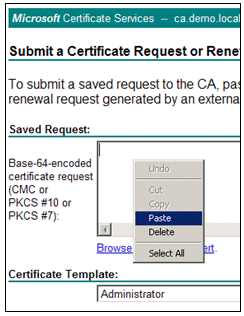
-
Choose ACS as the Certificate Template, and click Submit.
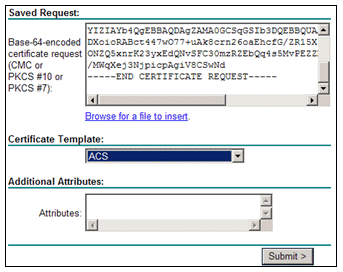
-
Once the Certificate is Issued, choose Base 64 encoded, and click Download certificate.
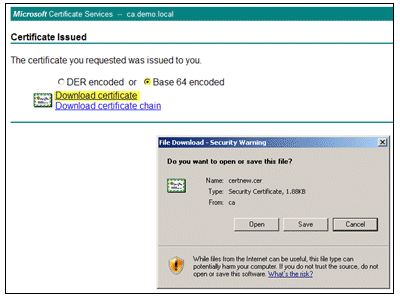
-
Click Save in order to save the certificate to the desktop.
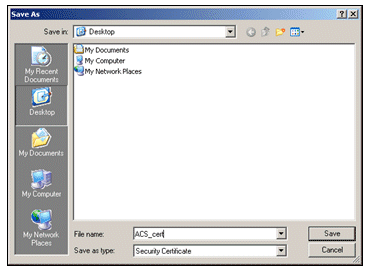
-
Go to ACS > System Administration > Configuration > Local Server Certificates. Choose Bind CA Signed Certificate, and click Next.
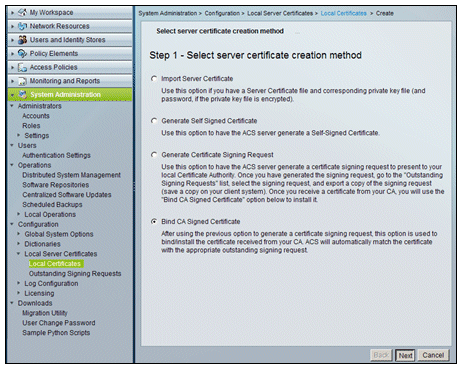
-
Click Browse, and locate the saved certificate.
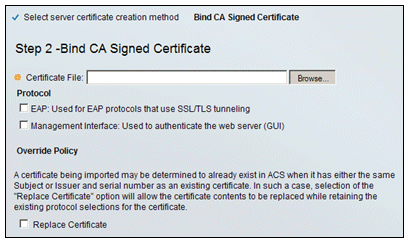
-
Choose the ACS certificate that was issued by the CA server, and click Open.
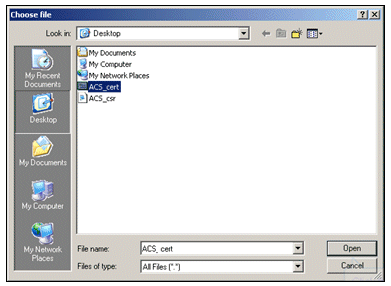
-
Also, check the Protocol box for EAP, and click Finish.
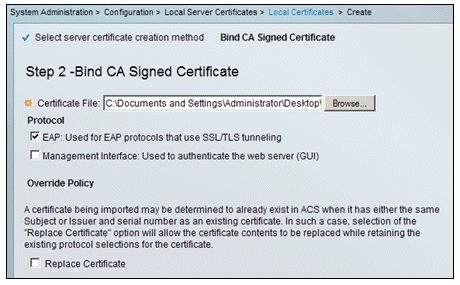
-
The CA-issued ACS certificate will appear in the ACS local certificate.
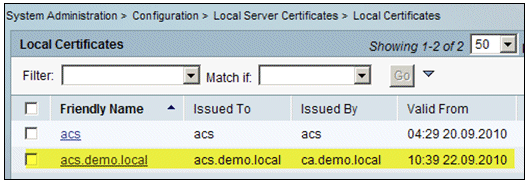
Configure ACS Identity Store for Active Directory
Perform these steps:
-
Connect to ACS and log in with Admin account.
-
Go to Users and Identity Stores > External Identity Stores > Active Directory.
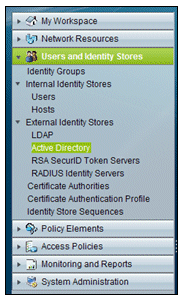
-
Enter the Active Directory Domain demo.local, enter the password of the server, and click Test Connection. Click OK in order to continue.
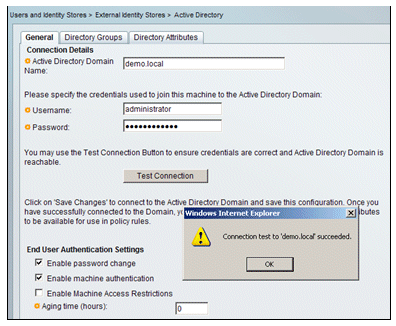
-
Click Save Changes.
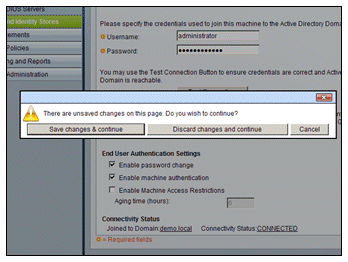
Note: For more information on ACS 5.x integration procedure refer to ACS 5.x and later: Integration with Microsoft Active Directory Configuration Example.
Add a Controller to ACS as an AAA Client
Perform these steps:
-
Connect to ACS, and go to Network Resources > Network Devices and AAA Clients. Click Create.
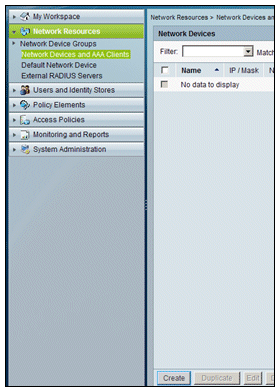
-
Enter into these fields:
-
Name - wlc
-
IP - 10.0.1.10
-
RADIUS checkbox - Checked
-
Shared Secret - cisco
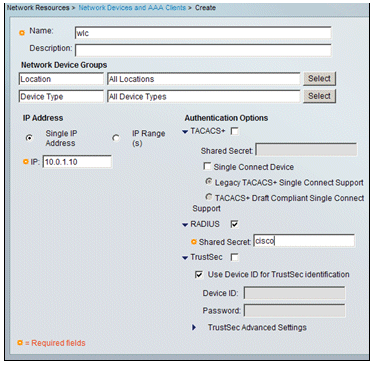
-
-
Click Submit when finished. The controller will appear as an entry in the ACS Network Devices list.
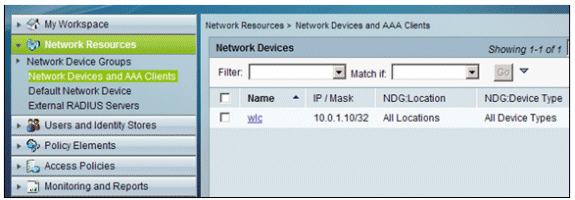
Configure ACS Access Policies for Wireless
Perform these steps:
-
In ACS, go to Access Policies > Access Services.
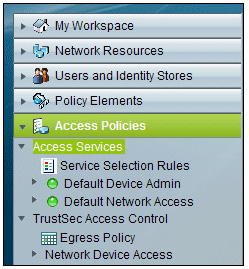
-
In the Access Services window, click Create.
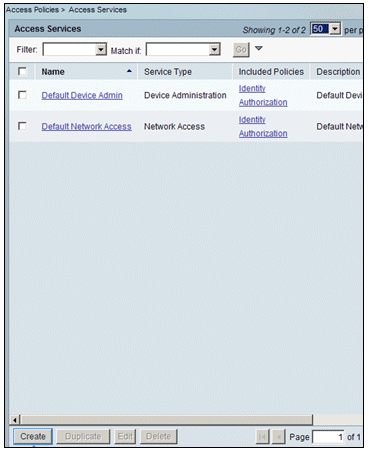
-
Create an access service, and enter a name (for example WirelessAD). Choose Based on service template, and click Select.
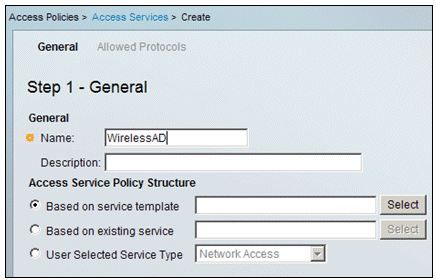
-
In the Webpage Dialog, choose Network Access – Simple. Click OK.
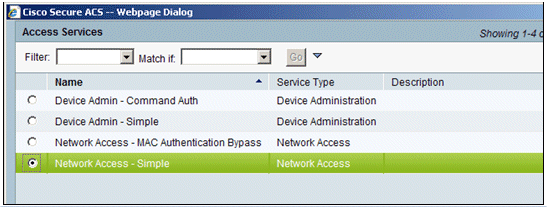
-
In the Webpage Dialog, choose Network Access – Simple. Click OK. Once the template is selected, click Next.
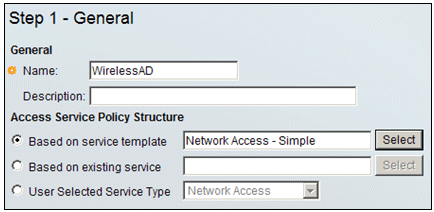
-
Under Allowed Protocols, check the boxes for Allow MS-CHAPv2 and Allow PEAP. Click Finish.
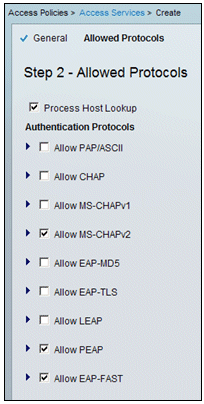
-
When ACS prompts you to activate the new service, click Yes.

-
In the new access service that was just created/activated, expand and choose Identity. For the Identity Source, click Select.
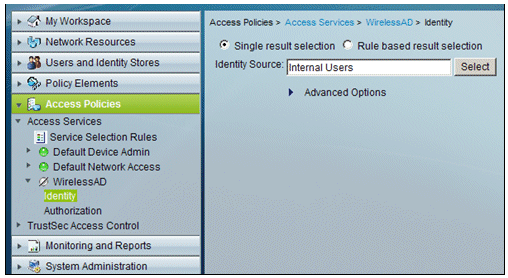
-
Choose AD1 for Active Directory that was configured in ACS, click OK.
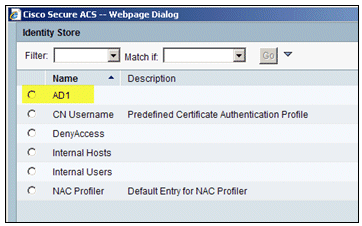
-
Confirm the Identity Source is AD1, and click Save Changes.

Create ACS Access Policy and Service Rule
Perform these steps:
-
Go to Access Policies > Service Selection Rules.
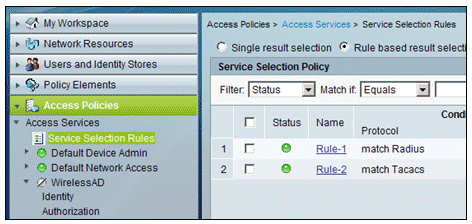
-
Click Create in the Service Selection Policy window. Give the new rule a name (for example, WirelessRule). Check the box for Protocol to match Radius.
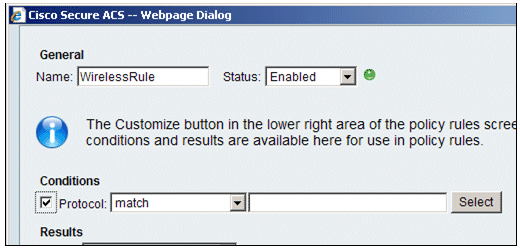
-
Choose Radius, and click OK.
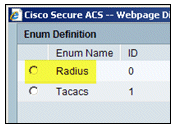
-
Under Results, choose WirelessAD for Service (created in previous step).

-
Once the new wireless rule is created, choose and Move this rule to the top, which will be the first rule to identify wireless radius authentication using Active Directory.
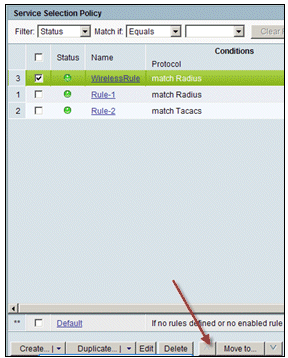
CLIENT Configuration for PEAP using Windows Zero Touch
In our example, CLIENT is a computer that runs Windows XP Professional with SP that acts as a wireless client and obtains access to Intranet resources through the wireless AP. Complete the procedures in this section in order to configure CLIENT as a wireless client.
Perform a Basic Installation and Configuraiton
Perform these steps:
-
Connect CLIENT to the Intranet network segment using an Ethernet cable connected to the hub.
-
On CLIENT, install Windows XP Professional with SP2 as a member computer named CLIENT of the demo.local domain.
-
Install Windows XP Professional with SP2. This must be installed in order to have PEAP support.
Note: Windows Firewall is automatically turned on in Windows XP Professional with SP2. Do not turn the firewall off.
Install the Wireless Network Adapter
Perform these steps:
-
Shut down the CLIENT computer.
-
Disconnect the CLIENT computer from the Intranet network segment.
-
Restart the CLIENT computer, and then log on using the local administrator account.
-
Install the wireless network adapter.
Note: Do not install the manufacturer's configuration software for the wireless adapter. Install the wireless network adapter drivers using the Add Hardware Wizard. Also, when prompted, provide the CD provided by the manufacturer or a disk with updated drivers for use with Windows XP Professional with SP2.
Configure the Wireless Network Connection
Perform these steps:
-
Log off and then log in using the WirelessUser account in the demo.local domain.
-
Choose Start > Control Panel, double-click Network Connections, and then right-click Wireless Network Connection.
-
Click Properties, go to the Wireless Networks tab, and make sure the Use Windows to configure my wireless network settings is checked.
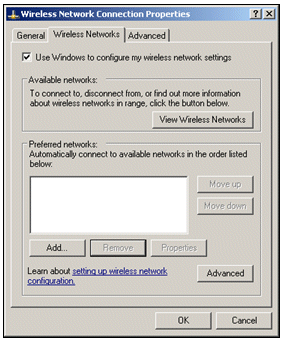
-
Click Add.
-
Under the Association tab, enter Employee in the Network name (SSID) field.
-
Choose WPA for the Network Authentication, and make sure that Data encryption is set to TKIP.
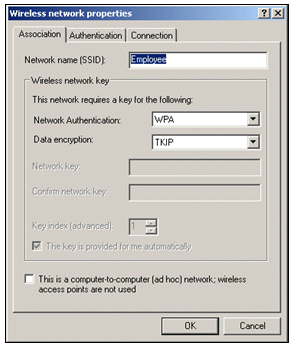
-
Click the Authentication tab.
-
Validate that EAP type is configured to use Protected EAP (PEAP). If it is not, choose it from the drop-down menu.
-
If you want the machine to be authenticated prior to login (which allows login scripts or group policy pushes to be applied), check Authenticate as computer when computer information is available.
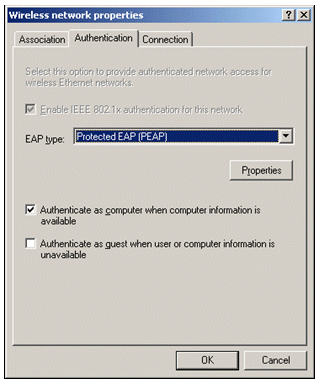
-
Click Properties.
-
As PEAP involves authentication of the Server by the client, ensure that the Validate server certificate is checked. Also, make sure the CA that issued the ACS certificate is checked under the Trusted Root Certification Authorities menu.
-
Choose Secured password (EAP-MSCHAP v2) under Authentication Method as it is used for inner authentication.
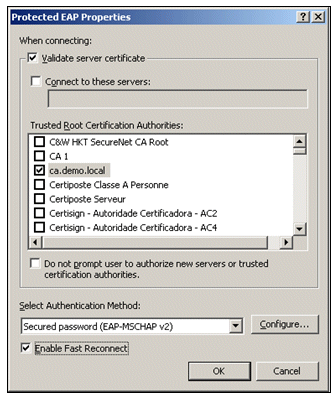
-
Make sure the Enable Fast Reconnect check box is checked. Then, click OK three times.
-
Right-click the wireless network connection icon in systray, and then click View Available Wireless Networks.
-
Click the Employee wireless network, and then click Connect. The wireless client will show Connected if the connection is successful.

-
After authentication is successful, check the TCP/IP configuration for the wireless adapter by using Network Connections. It should have an address range of 10.0.20.100-10.0.20.200 from the DHCP scope or the scope created for the CorpNet wireless clients.
-
In order to test functionality, open up a browser and browse to http://10.0.10.10 (or the IP address of the CA server).
Troubleshoot Wireless Authentication with ACS
Perform these steps:
-
Go to ACS > Monitoring and Reports, and click Launch Monitoring & Report Viewer.
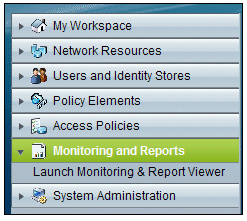
-
A separate ACS window will open. Click Dashboard.
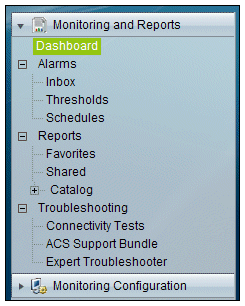
-
In the My Favorite Reports section, click Authentications – RADIUS – Today.
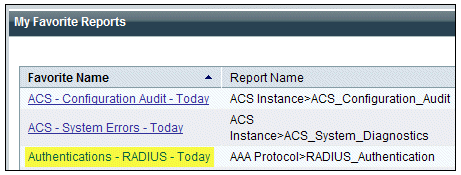
-
A log will show all RADIUS authentications as either Pass or Fail. Within a logged entry, click on the magnifying glass icon in the Details column.

-
The RADIUS Authentication Detail will provide much information about the logged attempts.
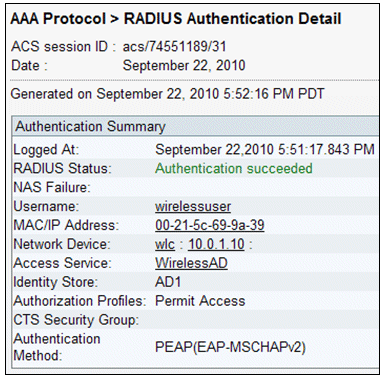
-
ACS Service Hit Count can provide an overview of attempts matching the rule(s) created in ACS. Go to ACS > Access Policies > Access Services, and click Service Selection Rules.
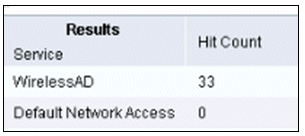
PEAP Authentication Fails with ACS Server
When your client fails PEAP authentication with an ACS server, check if you find the NAS duplicated authentication attempt error message in the Failed attempts option under the Report and Activity menu of the ACS.
You might receive this error message when Microsoft Windows XP SP2 is installed on the client machine and Windows XP SP2 authenticates against a third party server other than a Microsoft IAS server. In particular, Cisco RADIUS server (ACS) uses a different method to calculate the Extensible Authentication Protocol Type:Length:Value format (EAP-TLV) ID than the method Windows XP uses. Microsoft has identified this as a defect in the XP SP2 supplicant.
For a Hotfix, contact Microsoft and refer to the article PEAP authentication is not successful when you connect to a third-party RADIUS server ![]() . The underlying issue is that on the client side, with windows utility, the Fast Reconnect option is disabled for PEAP by default. However, this option is enabled by default on the server side (ACS). In order to resolve this issue, uncheck the Fast Reconnect option on the ACS server (under Global System Options). Alternatively, you can enable the Fast Reconnect option on the client side to resolve the issue.
. The underlying issue is that on the client side, with windows utility, the Fast Reconnect option is disabled for PEAP by default. However, this option is enabled by default on the server side (ACS). In order to resolve this issue, uncheck the Fast Reconnect option on the ACS server (under Global System Options). Alternatively, you can enable the Fast Reconnect option on the client side to resolve the issue.
Perorm these steps in order to enable Fast Reconnect on the client that runs Windows XP using Windows Utility:
-
Go to Start > Settings > Control Panel.
-
Double-click the Network Connections icon.
-
Right-click the Wireless Network Connection icon, and then click Properties.
-
Click the Wireless Networks tab.
-
Choose the Use Windows to configure my wireless network settings option in order to enable windows to configure the client adapter.
-
If you have already configured an SSID, choose the SSID and click Properties. If not, click New in order to add a new WLAN.
-
Enter the SSID under the Association tab. Make sure that Network Authentication is Open and Data Encryption is set to WEP.
-
Click Authentication.
-
Choose the Enable IEEE 802.1x authentication for this network option.
-
Choose PEAP as the EAP Type, and click Properties.
-
Choose the Enable Fast Reconnect option at the bottom of the page.
Related Information
- PEAP under Unified Wireless Networks with ACS 4.0 and Windows 2003
- Cisco Wireless LAN Controller (WLC) and Cisco ACS 5.x (TACACS+) Configuration Example for Web Authentication
- Installation and Upgrade Guide for the Cisco Secure Access Control System 5.1
- Technical Support & Documentation - Cisco Systems
Revision History
| Revision | Publish Date | Comments |
|---|---|---|
1.0 |
08-Oct-2010 |
Initial Release |
Contact Cisco
- Open a Support Case

- (Requires a Cisco Service Contract)






































































































 Feedback
Feedback